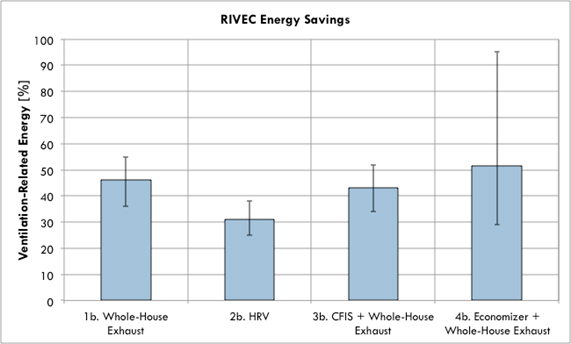One current smart-ventilation controller prototype, developed by LBNL scientists, is called Residential Integrated Ventilation Energy Controller (RIVEC). RIVEC controls a whole-house ventilation system in real time by continuously calculating pollutant dose and exposure relative to a continuous ventilation system.
What Can RIVEC Do?
- Use timers or temperature sensors to provide ventilation when the energy and peak-demand is the least. This typically shifts ventilation from times of high temperature differences to times of low temperature difference. This approach saves energy and reduces the building’s electricity demand. This peak-demand reduction (Turner et al., 2015), also increases grid reliability.
- Account for operation of other air-moving equipment, like kitchen and bathroom exhaust fans, and clothes dryers.
- Reduce ventilation during unoccupied times.
- Increase ventilation at certain times to compensate for other times when RIVEC reduced ventilation.
- Increase ventilation to avoid acute pollutant exposures.
- Include the use of passive ventilation systems.
RIVEC’s Performance Evaluation
RIVEC underwent a six-day field evaluation. From these measurements the scientist performed energy simulations over the year. The estimated energy savings at 1000 kWh. RIVEC reduced the run time of the fans by up to 71% for a home with an econmizer. The whole-house fan must be oversized by 25% to allow it to provide sufficient off-peak ventilation rates.

LBNL scientists field-tested the RIVEC prototype in an occupied house in Moraga, California. RIVEC ventilation run-times were 30-70% of continuous operation. The scientists combined experimental data with modeling to estimate the annual energy savings. They surveyed three Californian climate zones (temperate – Oakland, warm – Fresno, cold mountain – Mt Shasta). Their modeling showed a potential of 13-44% annual ventilation energy savings. while eliminating 100% of the ventilation’s peak power. IAQ remained as good or better than continuous ventilation.
In order to obtain sufficient representation of the Californian housing stock, the scientists estimated the ventilation energy savings to be at least 40%. Studies of California’s 16 unique climates, various home geometries, and values for envelope airtightness were the basis of these estimates. This multi-climate estimate reflects absolute energy savings between 500 and 7000 kWh/year per household with a peak power reduction up to 2 kW for a typical home.
Can We Control Particles and Ozone?
Another aspect of smart-ventilation controllers is to control exposure to outdoor pollutants – typically ozone and particles. RIVEC simulated a smart ventilation strategy in typical single-family homes located in two places in California. The simulation switched off the ventilation fan during outdoor ozone peaks levels. (Walker and Sherman, 2013). The LBNL scientists demonstrated reductions of 10-40% in indoor-to-outdoor ozone ratios, compared to continuously operating ventilation systems.
Further Reading
Advanced Controls for Residential Whole-House Ventilation Systems., 2014.
Advanced Controls and Sustainable Systems for Residential Ventilation., 2012.
Development of a Residential Integrated Ventilation Controller., 2012.